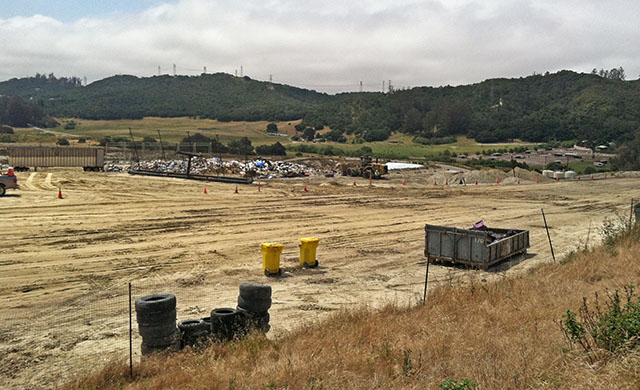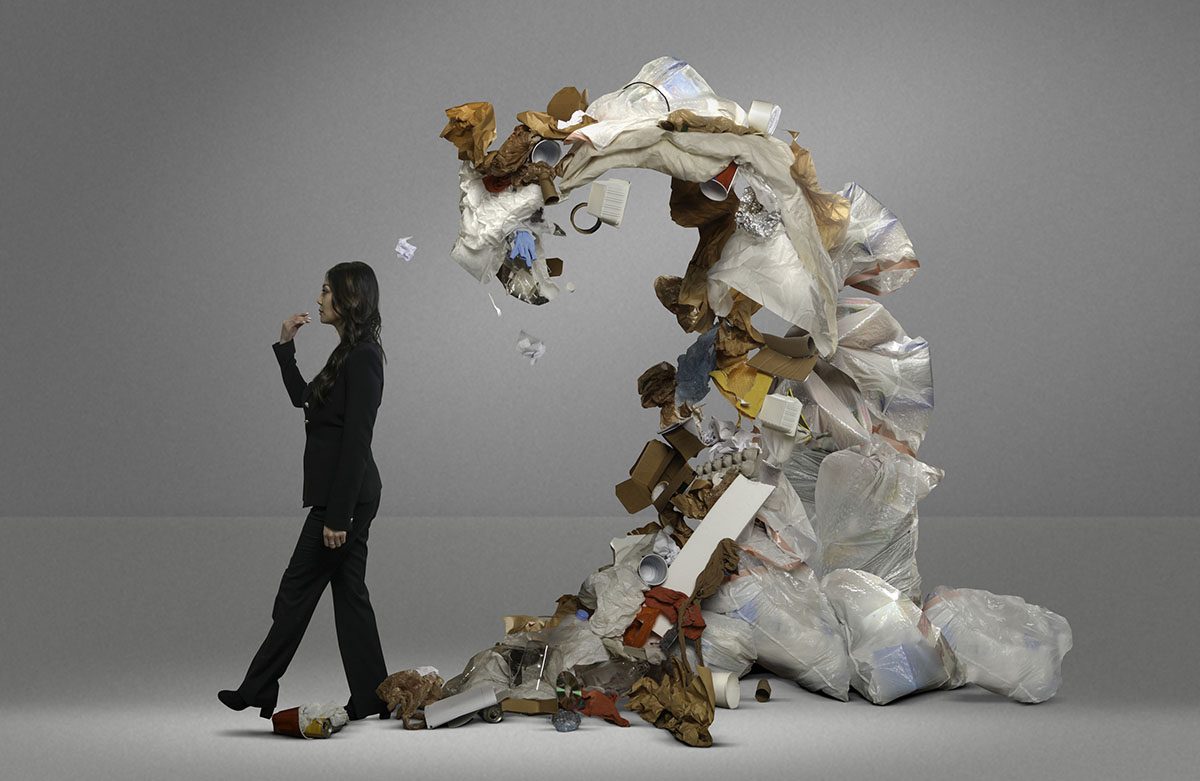I double dog dare you to visit your local landfill to see what happens to your garbage. Afterward, ask yourself how you can improve your own waste habits.
Think of touring a landfill as a cross between an interesting field trip and a civic duty. Add to the fun with a side trip to a materials recovery facility also called an MRF (pronounced “murf”).
Each week, you, I, and everyone else toss our solid waste into garbage, recycling, and green waste bins, perhaps without much thought about what goes where. Then, once a week, while we are at work, school, sleeping, running errands, or otherwise going about our day, the contents of these bins are magically whisked away.

The problem is that there is no “away” and the environmental impact of landfills is enormous.
Environmental Impact of Landfills
Nowadays, at least in the U.S., landfills operate under more stringent regulations than in the past. Environmental issues vary widely depending on a number of factors including landfill size, location, design, contents, age, and how it is operated and managed.

- Landfills take up large amounts of land displacing plants, animals, and even people.
- Slowly decomposing plant, animal and human waste produce methane, which is a greenhouse gas 20 times more powerful than CO2. According to the U.S. EPA, landfills are the third-largest source of human-related methane emissions in the country.
- Rainfall and moisture can cause toxic chemicals to leach into streams, lakes, and groundwater killing aquatic life and endangering drinking water.
- Air pollution is created by trucks collecting and transporting garbage and by dust and other particulate matter churned up at the landfill.
- When reusable and recyclable materials are buried in a landfill, the energy, resources, and people power that went into making them is wasted.
To me, the biggest environmental impact of landfills is that they enable and even encourage consumerism and wasteful practices. Our waste is conveniently tucked away out of our sight so we do not have to think about it.
The Trash Trifecta
I acknowledge that I might be a wee bit more fascinated by garbage than many people. For instance, one of my favorite nonfiction books is Garbology by Edward Humes. I have also written at least 35 posts that have some connection to waste.
So, you can probably imagine my excitement when, recently, I had the opportunity to visit a landfill, MRF, and an anaerobic digester all on the same day. I was in solid waste heaven.
Below, you will get a glimpse into what happens at a landfill and a materials recovery facility. We will take a look at the anaerobic digester in the next post.
I live in a small town on the Central California Coast in San Luis Obispo County, CA where the entire population is about 285,000 people. My household’s garbage goes to Cold Canyon Landfill the largest of the three landfills in the County. Based on the permitted capacities of the three landfills I estimate that Cold Canyon Landfill takes in 60-70% of the County’s solid waste.

Although landfills and MRFs operate in a similar manner across the U.S. there are differences and capabilities may vary considerably. For instance, some MRFs have equipment that enables them to process difficult to handle items like single-use plastic bags, but many like the one where I live, do not.
At the Landfill
At the Cold Canyon Landfill, my spouse and I joined students from the California Naturalist Program at Cuesta College. Our host was Mike di Milo. He is the owner of Science Discovery the company that runs education programs on behalf of the San Luis Obispo County Integrated Waste Management Authority.
After donning electric yellow safety vests, we bundled into several vehicles for a short trip into the landfill and stopped on a section of road that overlooked the day’s activities. Mike had us stand in a group while he shared facts about the landfill and talked about how it works.
Engineering
You may think a landfill is just a pit, but that is not the case, at least at Cold Canyon. The landfill is carefully engineered and monitored.

The excavated area currently being used was lined with plastic, clay, and gravel before any garbage was put in it. A drainage system diverts stormwater runoff to a settling pond to keep sediment out of nearby Pismo Creek. The compacted garbage is arranged into layers about 15-20 feet high and then covered with about 2 feet of compacted soil. The top is seeded to grow plants and grasses to reduce erosion.
Operations
Cold Canyon Landfill takes in about 1 million pounds (500 tons) of garbage a day six days a week. Our visit was during the morning before most of the municipal garbage trucks had come by to dump their loads so the pile of garbage was small.
We watched as pickup trucks pulled up alongside big garbage trucks at the edge of the garbage pile and dumped their loads. The bulldozer operator maneuvered nimbly around the trucks staying out of the way but constantly pushing the pile toward the pit. Another heavy equipment operator focused on getting the garbage compacted in a designated area.
On windy days, large litter screens are strategically placed to stop garbage from flying out of the landfill.
At the end of the day, the garbage is covered with tarps until the next day. This practice eliminates the need for a daily layer of dirt allowing the landfill to extend its useful life because there is room for more garbage.
Mike pointed out the above ground pipes running across the top of the covered landfill sections that capture and transport methane gas produced by the landfill. Burning the methane generates power for the landfill and the Arroyo Grande Oil Field in Price Canyon.
We learned that there is a section for collecting separated demolition and construction materials. Lower dumping (tipping) fees encourage contractors to do this, but it is not mandatory. There is also a place on site where residents can drop off their household hazardous waste like used motor oil, paint, and pesticides.
Environmentally Friendly Pest Control
After Mike filled us with information, we had the pleasure of meeting a falconer named Aaron and a magnificent Harris’s hawk.

Aaron cares for and works with this hawk and four other birds of prey. They keep the volume of seagulls flying around the open garbage pile in check. Swarming seagulls can make working conditions unsafe and present a health hazard when they pick up garbage, fly away with it, and leave it somewhere else.
After talking with Aaron and admiring the hawk, we got back in our vehicles to drive over to the MRF.
At the Materials Recovery Facility (MRF)
As we drove up to the MRF, I spotted a truck pausing momentarily at a weigh station. Recycling and garbage tipping fees are based on weight. The truck is weighed again after it is empty.
Visitors are not allowed to go into the actual MRF so we gathered in the education center. This space has a large glass window where you can watch the action, interactive displays, and rows of chairs in front of a large movie screen.

Mike lured us away from the window to watch live action feeds on the screen from various cameras mounted inside the MRF.
A heavy equipment operator used a big clunky grabber mounted at the end of an articulating arm to pick up materials from a huge pile and move them to the conveyor belt intake area. The operator also delicately selected unrecyclable materials like plastic bags, box strapping, and garden hoses and dropped them over a low wall into another pile. Later these materials would be picked up and transported to the landfill.
The facility was a maze of conveyor belts, machines, and bins. Materials were being separated by machines and people. Workers standing in small areas (kind of like waist high turrets) adjacent to the conveyor belts removed trash and recyclable materials and tossed them in nearby chutes or bins.
At the end of the process, separated materials enter a baler and come out as strapped cubes of materials like cardboard, plastic bottles, and aluminum cans. I did not see what happened to glass or paper.
The amount of garbage mixed in with recyclable materials was shocking. Mike said that as much as 25% or more of the materials that come into the MRF are not recyclable. In this facility, it was easy to see that it is not equipped to handle things like plastic bags or little bits of anything.

The California Naturalists were on a tight schedule so we thanked Mike, carpooled back to the entrance, and dispersed.
My Takeaways
Seeing what actually happens to the contents of my garbage and recycling bins made a big impact on me. Faced with the reality I cannot hold on to my wishful thinking anymore. Here are some of my thoughts.
- The people who work at the landfill and MRF work in dirty, noisy, and smelly conditions and they know what they are doing.
- There is no one sorting through the garbage mound looking for and setting aside reusable or recyclable materials. Everything dumped on the landfill deck goes into the pit.
- The MRF is not a precision operation. Some recyclable materials end up accidentally going to the landfill. Some recyclable materials are contaminated by substances or materials that do not get separated out making them unusable and unsellable.
I came away committed to continuing to find ways to reduce the amount of solid waste our household produces and to sort it into the right bins.
It occurs to me, that every week, you, I, and everyone else have an opportunity to positively impact the environment when we take out the trash.
Featured Image at Top: A woman tossing trash over her shoulder is being followed by a wave of garbage – photo credit iStock/ pick-uppath.
Related Posts
- America Recycles Day – Aluminum Cans and E-Waste
- Anaerobic Digesters are Good for the Environment
- Are You an Aspirational Recycler?
- Composting can Change Our Culture
- Cradle to Cradle – Book Review
- E-Waste Health Hazards and Environmental Impacts
- Garbology – Book Review
- Repairing Things is the Antidote for Our Throwaway Society
- Safely Disposing of Expired and Leftover Medications is Easy
- The Story of Stuff – Book Review
- The Upcycle – Book Review
- Three Easy Ways to Cut Your Single-Use Plastic Bag Waste
- We Drink What We Dump – Household Hazardous Waste
Resources
- Court Orders EPA to Address Landfill Emissions – by Ellen M. Gilmer, E&E News, 05/07/19, reprinted by Scientific American
- Facts and Figures about Materials, Waste, and Recycling – U.S. Environmental Protection Agency
- Fast Fashion Is Creating an Environmental Crisis – by Alden Wicker, Newsweek, 09/01/16
- There is No Away – by Suzan Beraza, 2014 (9:24-minute video well worth watching)
- What are the trends in wastes and their effects on human health and the environment? – U.S. Environmental Protection Agency

